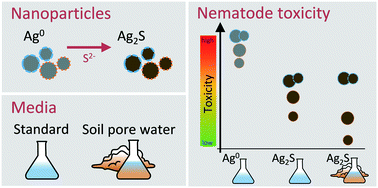Chemical transformation and surface functionalisation affect the potential to group nanoparticles for risk assessment†
Abstract
A major challenge in nanomaterial environmental risk assessment is to identify whether different manufactured materials need to be assessed individually or if they can be grouped for assessments based on selected properties. To date, NPs are grouped on the basis that they are manufactured (e.g., pristine materials), but these are rarely present in the environment as many nanomaterials transform before and after entry into the environment. To assess how transformations change relative hazard and, therefore, the potential for grouping, we assessed the toxicity of silver nanoparticles (NPs) of varying sizes (20, 50 nm) and surface functionalisation (PVP, citrate) in their metallic and sulphidised forms to Caenorhabditis elegans in a standard medium lacking organic matter and in extracted soil pore water. The metallic Ag NPs showed only small variations in toxicity, with citrate functionalisation reducing potency and small citrate NPs being least toxic. The toxicity of sulphidised particles was lower than for the pristine forms in all cases, however relative differences among the transformed materials were greater than for the metallic forms. Exposure in soil pore water further reduced toxicity of the citrate, but not PVP functionalised NPs. Overall, transformation reduced citrate functionalised NP toxicity in a size dependent manner, whereas PVP coating preserved similarities across sizes and transformations. Thus despite similar toxicity of the pristine materials, grouping of NPs with a similar coating independent of size appeared only possible for materials with the more persistent PVP surface coating and then only when transformations were first considered.



 Please wait while we load your content...
Please wait while we load your content...